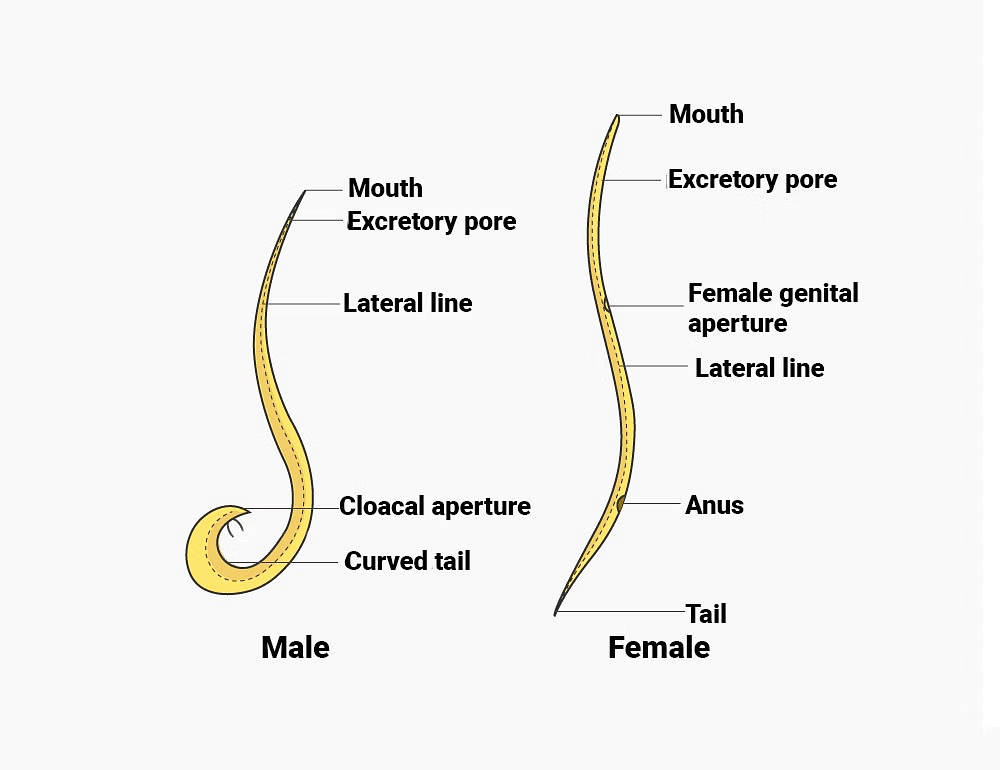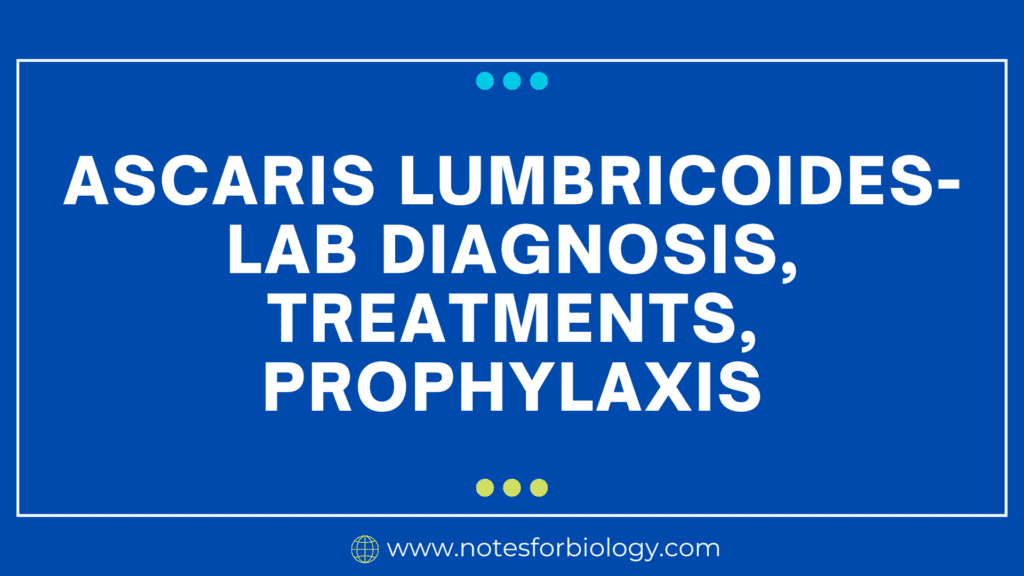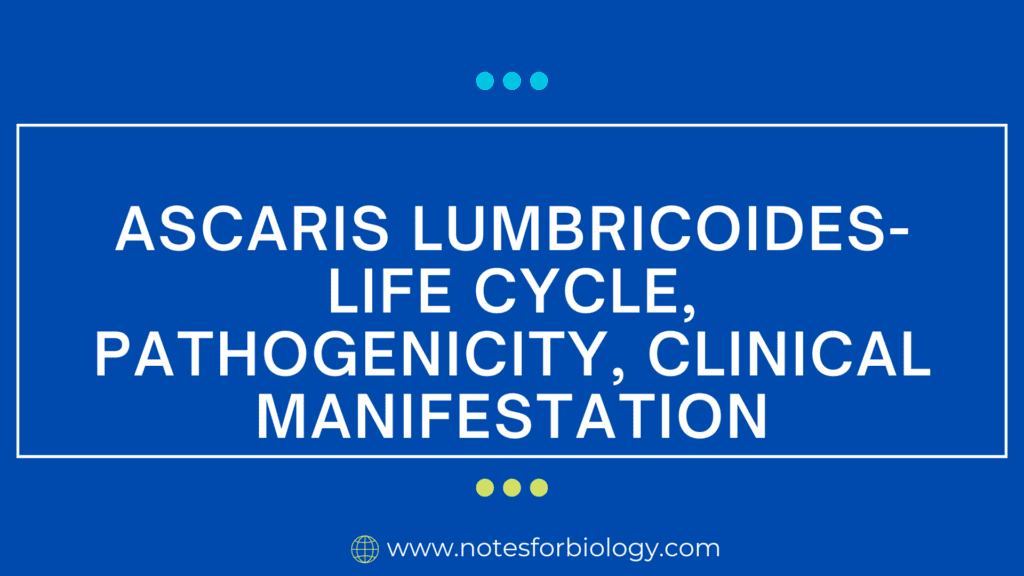Ascaris lumbricoides, also referred to as the huge roundworm, is a parasitic worm that infects people, especially in areas with inadequate sanitation. It is the biggest intestinal nematode that infects people, and infections are most common in tropical and subtropical locations.
Table of Contents
Lab Diagnosis of Ascaris lumbricoides

Microscopic Examination
1. Stool Examination
The basic way for identifying Ascaris lumbricoides is to find its eggs in a stool sample. Several kinds of eggs can be identified:
Fertile eggs: They are round or oval in shape and are 45-75 micrometers in length. They have a thick, mammillated outer shell and a clear inner membrane. They have a growing embryo.
Infertile eggs: They are longer and more elliptical, measuring 85-95 micrometers, with a thinner shell and uneven interior content.
2. Direct Smear Method
A tiny sample of excrement is smeared onto a microscope slide, stained as needed, and inspected under a microscope for the presence of eggs.
3. Concentration Techniques
These procedures use a larger amount of excrement to concentrate Ascaris eggs, increasing the likelihood of detection.
Formal-Ether Sedimentation: It is a process for separating eggs from trash based on density, making them easier to recognize.
Zinc Sulfate Flotation: Eggs are floated to the surface using a zinc sulfate solution and then collected for microscopic analysis.
Larval Detection
Sputum Examination: When larvae travel to the lungs, they can be found in sputum samples.
Gastric Lavage: In extreme cases, larvae may be detected in gastric contents collected via lavage.
Serological Tests
Enzyme-Linked Immunosorbent Assay (ELISA): This test detect antibodies to Ascaris antigens in the blood, indicating an immunological response to infection. Although helpful, it is rarely used for routine diagnosis due to cross-reactivity with other helminth diseases.
Western Blot: Another serological approach for more specific identification of Ascaris antibodies.
Imaging Techniques
Abdominal X-ray: Sometimes used to detect the presence of adult worms in the intestines, especially when the illness is severe. Worms might show as coiled or linear structures in the intestines.
Ultrasound: Can detect mature worms in the intestines or, in rare situations, in the biliary or pancreatic ducts.
Computed Tomography (CT) or Magnetic Resonance Imaging (MRI): Although these imaging techniques are infrequently utilized, they can detect issues such as intestinal blockage or abnormal worm movement.
Endoscopy
Upper Gastrointestinal Endoscopy: Can be used to directly visualize and sometimes retrieve worms in the stomach or duodenum.
Thus, The laboratory diagnosis of Ascaris lumbricoides is based mostly on the finding of eggs in stool samples under a microscope. Concentration approaches increase the sensitivity of egg detection. In some circumstances, larvae might be detected in sputum or gastric lavage samples. Serological tests, such as ELISA, can help with the diagnosis, especially when a stool examination is ambiguous, but they are less usually utilized. Imaging methods and endoscopy can help diagnose complex infections and visualize mature worms.
Treatments of Ascaris lumbricoides
Anthelmintic Drugs
- These drugs operate by paralyzing or killing mature worms, which are then evacuated through the stool.
- Albendazole: It s the medicine of choice. A single dose of 400 mg is effective.
- Mebendazole: It is another typical therapy. The dosage is 100 mg twice daily for three days, or a single dose of 500 mg.
- Ivermectin: A single dose of 150-200 mcg/kg is effective.
- Pyrantel Pamoate: A single dose of 11 mg/kg (up to 1 g) can also be used.
Supportive Care
- Symptomatic Treatment: For problems such intestinal blockage or biliary ascariasis, surgery or endoscopic removal may be required.
- Nutritional Support: In cases of severe infection resulting in malnutrition, food supplementation may be required.
Prophylaxis–of Ascaris lumbricoides
Sanitation and hygiene
Improved Sanitation: Proper disposal of human excrement to avoid soil pollution.
Handwashing: Always wash your hands with soap, especially before eating and after using the restroom.
Food Safety: Thoroughly washing fruits and vegetables and properly boiling food to kill any remaining eggs.
Health Education
Community Education: Raising knowledge regarding the spread and prevention of Ascaris lumbricoides.
School-based programs: Educate youngsters about the importance of cleanliness and sanitation.
Mass Drug Administration (MDA)
Periodic deworming programs: Targets high-risk groups such as school-aged children and provide anthelmintic medications on a regular basis.
WHO recommendations: Periodic therapy is advised in locations with a high frequency of soil-transmitted helminths (every 6–12 months).
Environmental Measures
Clean Water Supply: Providing access to clean water in order to limit the possibility of pollution.
Sanitation Facilities: Establishing and maintaining latrines or toilets to reduce open defecation.
In conclusion, Ascaris lumbricoides is a major public health concern, especially in places with poor sanitation and hygiene practices. Effective care of this parasite infection is dependent on precise laboratory diagnosis, which usually entails microscopic analysis of stool samples to find distinctive eggs. Advanced serological tests and imaging techniques supplement traditional approaches, particularly in complex patients. Anthelmintic medications, such as albendazole and mebendazole, are particularly effective at eliminating the illness. However, treating the underlying causes through better sanitation, health education, and regular deworming programs is critical for long-term control and prevention. Comprehensive initiatives that include diagnostic, therapeutic, and preventative techniques can drastically lower the prevalence of Ascaris lumbricoides infections while also improving health outcomes in affected communities.
Frequently Asked Questions (FAQ)
How are humans infected by Ascaris lumbricoides?
When eggs from contaminated food, water, or soil are consumed by humans, they can become sick.
What symptoms indicate an Ascaris infection?
Symptoms may include abdominal pain, malnutrition, growth retardation in children, cough, and, in extreme cases, intestinal blockage.
Who is most at risk for Ascaris infection?
Individuals in tropical and subtropical climates with poor sanitation, particularly youngsters, are at greater risk.
Related Articles




